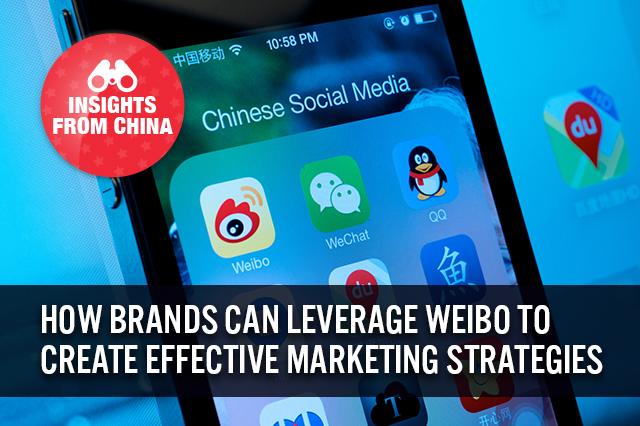
DIpil Das
Weibo: The Largest Micro-Blogging Platform in China
Launched in 2009, Weibo was one of first social media platforms in China, and it is one of the largest. The micro-blogging site combines features of Facebook and Twitter. Although Weibo has been overshadowed by the rise of WeChat and other new platforms such as Douyin (China’s TikTok) and RED (Xiaohongshu) in recent years, it remains a popular site for marketing due to its 516 million monthly active users (MAUs). According to third-party data firm QuestMobile, Weibo is the third-largest social media site in terms of MAUs as of March 2020, just behind WeChat and Tencent’s instant-messaging platform QQ. Weibo has a young user base, with over 80% under the age of 30, according to research firm iResearch. In addition, almost half of the site’s users are from lower-tier markets in China.
Besides posting and distributing content, users on Weibo leverage the platform for trend-spotting and following celebrities and influencers, as well as it being a source of news. During the coronavirus outbreak in China, Weibo reported a 30% traffic surge, with users looking for authoritative information on the pandemic. Most regional governments and organizations have an official Weibo account through which they share the latest information: The site’s open and public nature allows news to spread instantly in a wide reach.
Weibo has been expanding its features since its launch, to incorporate short videos, e-commerce, Instagram-like story functionality and livestreaming capabilities—making it a comprehensive social platform that brands can tap into to increase brand awareness, attract and engage with followers and ultimately drive sales.
[caption id="attachment_109437" align="aligncenter" width="700"] Note: Percentages may not sum to 100 due to rounding
Note: Percentages may not sum to 100 due to rounding
*“DAUs” stands for daily active users
**“New Tier 1” comprises 15 cities based on five criteria—availability of commercial resources, connectivity, livability, lifestyle diversity and future growth potential—as defined by Chinese news source Yicai Global
Source: Sina Weibo/iResearch/FABERNOVEL [/caption] Creating an Effective Weibo Marketing Strategy To get started, brands need to first register an official account. After verification, they can customize the account’s homepage with banners, a cover page and background pictures. The next step would be to create engaging posts to attract followers, such as new product launches, promotional campaigns and event information. Similar to Twitter, Weibo has the hashtag function that leads users to a dedicated page for posts on same topic. Popular hashtags are also shown on Weibo’s “hot search list,” which would enable brands to create a wide-reaching impression if their content was featured. There are three types of common promotional campaigns that brands can launch on Weibo: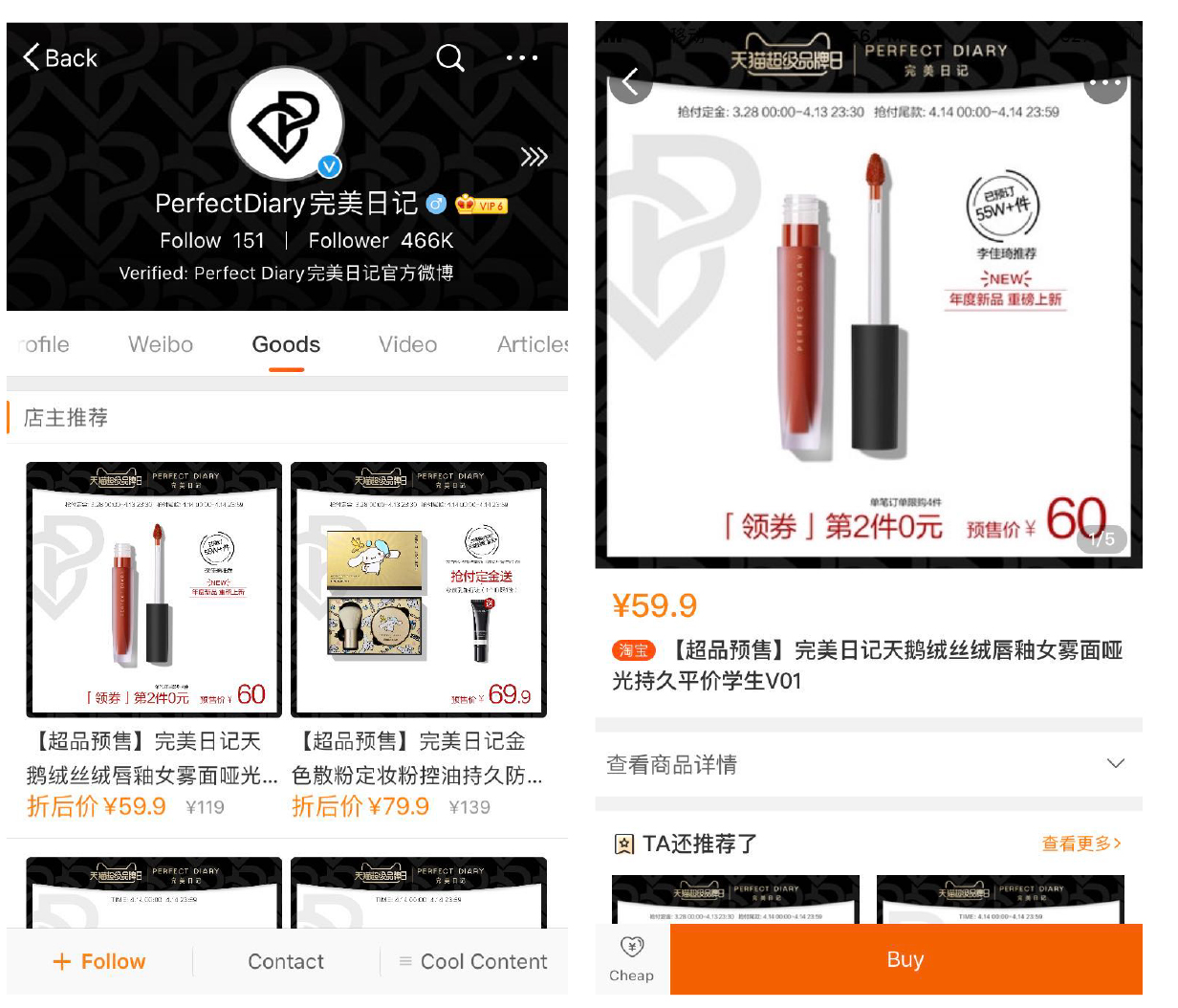 Xiaodian enables users and brands to sell products through Weibo
Xiaodian enables users and brands to sell products through Weibo
Source: Weibo [/caption] Impressions and Engagement through Weibo Ads With 87% of its revenue coming from advertising and marketing in 2019, Weibo offers a variety of advertising solutions for brands to drive impressions and engagement on the platform. There are five types of ads that brands can leverage on the platform: 1. Open screen ads are full-screen advertisements that pop up for three to four seconds when a Weibo user opens the app. The format can vary from a poster to a video, with embedded links to specific landing pages. This type of ad enables brands to gain maximum impressions since it is shown to every user and is not skippable until a few seconds pass. 2. SuperFans ads are placed within the user feeds section of the site, based on an algorithm that determines target consumers. The format can be posters or videos with click-through links to the brand’s pages or external e-commerce platforms. This is an effective way to drive sales, as Weibo provides one-click “add to cart” functionality. [caption id="attachment_109439" align="aligncenter" width="700"]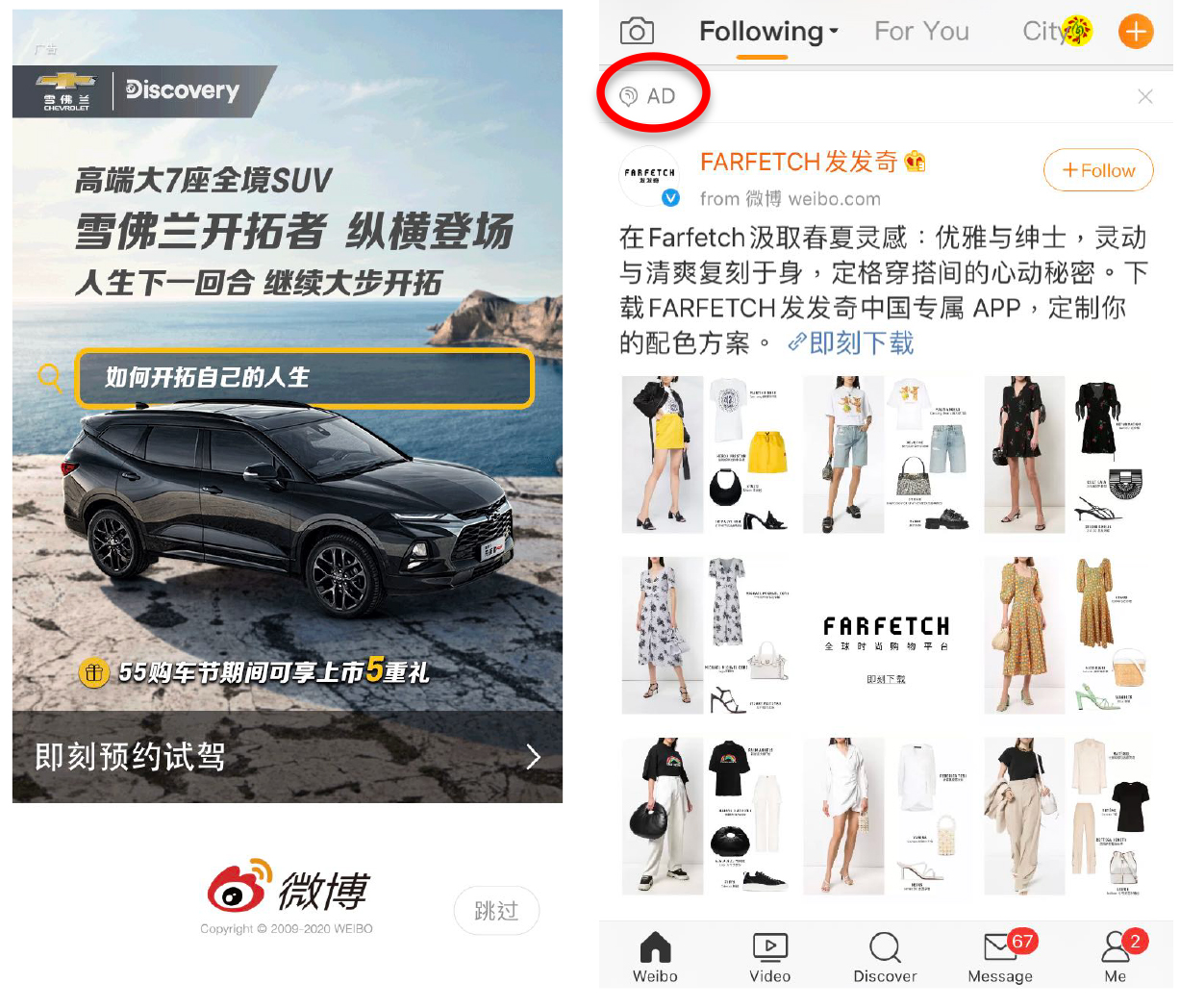 Open screen ad (left) and SuperFans ad (right) on Weibo
Open screen ad (left) and SuperFans ad (right) on Weibo
Source: Weibo [/caption] 3. Hot search ads are displayed as customized keywords on Weibo’s “hot search” ranked list. Users have to click the keyword to see the ad. Brands can use this to generate discussions on specific topics and boost engagement. In addition, brands can purchase a search topic or keyword on Weibo so that their content will be recommended as the top-listed result in the search bar. [caption id="attachment_109440" align="aligncenter" width="700"]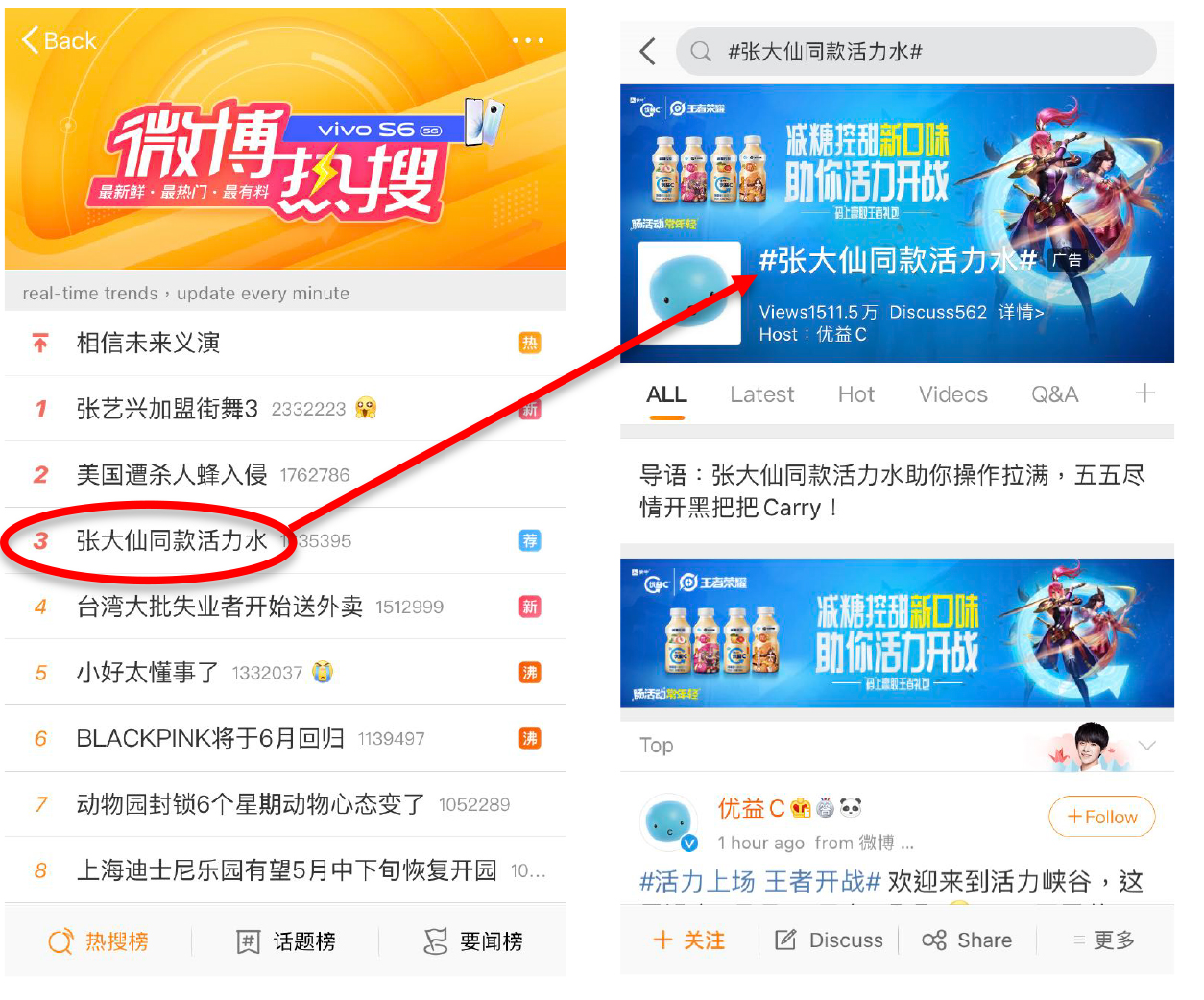 Weibo hot search ad
Weibo hot search ad
Source: Weibo [/caption] 4. Video ads are similar to Instagram stories adverts. They are positioned at the top of a Weibo user’s feed page, aggregated with the brand’s or author’s profile icon as the entry. Brands can post a 15-second video with interesting filters, effects or stickers provided by Weibo. The story post will disappear after 24 hours. 5. Floating ads are pictures that appear in the search section of site and direct users to the “hot search” page. Similar as the open screen ad, this type of advert comprises a full-screen display that can make the largest visual impact to attract users’ attention. [caption id="attachment_109441" align="aligncenter" width="700"]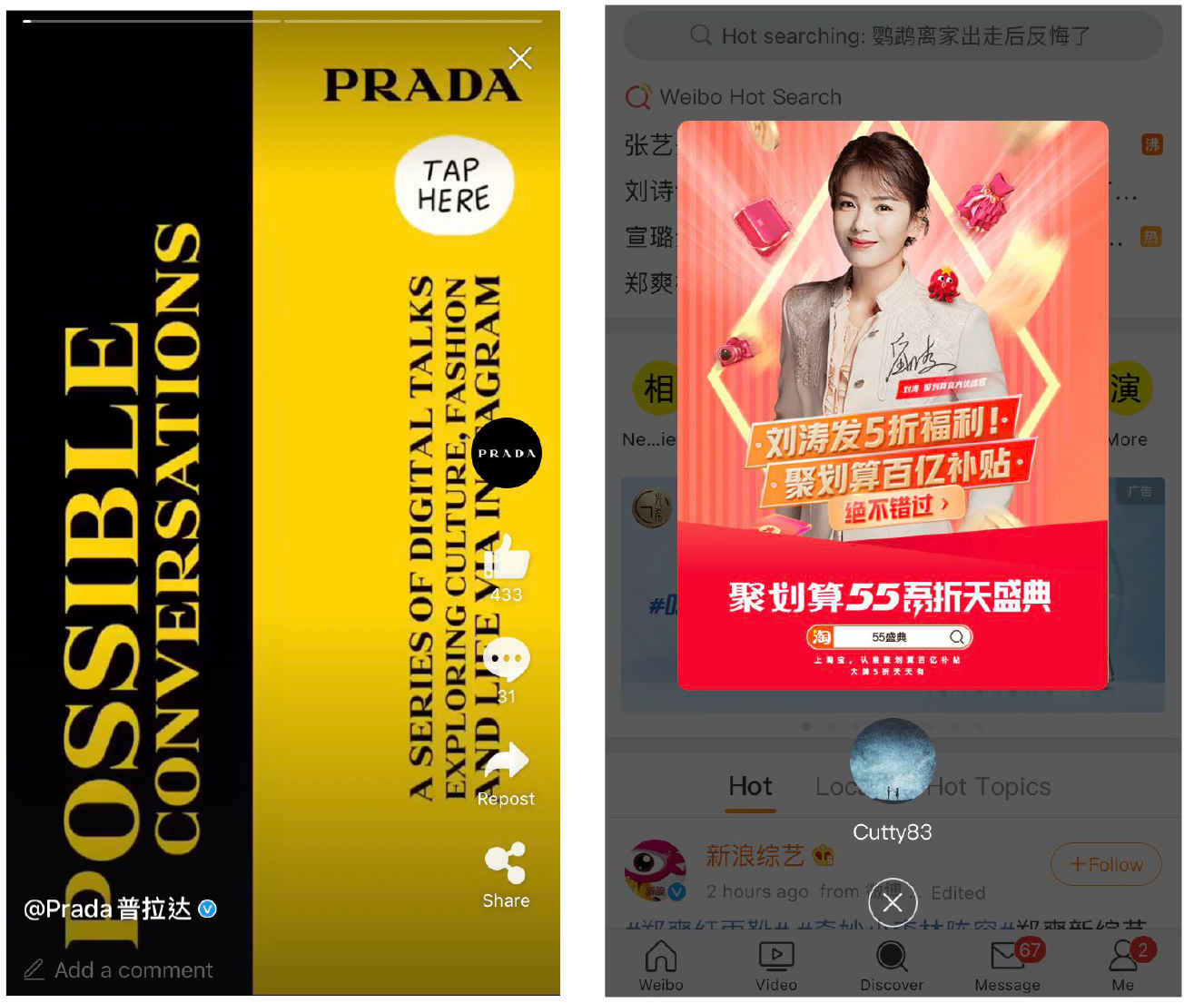 Prada’s Weibo story (left); Weibo floating ad (right)
Prada’s Weibo story (left); Weibo floating ad (right)
Source: Weibo [/caption] Brands need to have clear business goals before deciding which Weibo ads to use. Open screen ads are most effective to generate impressions, while hot search and topic ads are used to drive discussions and engagement. SuperFans ads have the most versatile format, as they comprise posts made up of text, pictures and videos. Brands can also mention influencers’ names in the post to boost interaction and add customized links to e-commerce site to drive sales. We look at some of the successful marketing campaigns on Weibo: SK-II campaign for its new limited-edition essence
SK-II campaign for its new limited-edition essence
Source: Weibo [/caption] Kate Spade invited Weibo users to participate in a style-matching game
Kate Spade invited Weibo users to participate in a style-matching game
Source: Weibo [/caption] Implications for Brands As one of the largest social media platforms in China, Weibo is poised to be a valuable site that brands can use to engage with Chinese consumers and increase brand awareness. Previously, Weibo was a content sharing site for brands to distribute latest brand information, events and promotions, and it has been expanding its features to incorporate short videos, e-commerce, Instagram-like stories and livestreaming in recent years. To create a solid marketing strategy that leverages Weibo, brands should start creating engaging posts with relevant hashtags, as well as launch promotional campaigns. Weibo is an open platform that requires consistent and frequent content and engagement to make the best use of its features. Weibo also offers a powerful suite of advertising solutions that brands can leverage—using a combination of different ads to achieve their business goals.
 Note: Percentages may not sum to 100 due to rounding
Note: Percentages may not sum to 100 due to rounding *“DAUs” stands for daily active users
**“New Tier 1” comprises 15 cities based on five criteria—availability of commercial resources, connectivity, livability, lifestyle diversity and future growth potential—as defined by Chinese news source Yicai Global
Source: Sina Weibo/iResearch/FABERNOVEL [/caption] Creating an Effective Weibo Marketing Strategy To get started, brands need to first register an official account. After verification, they can customize the account’s homepage with banners, a cover page and background pictures. The next step would be to create engaging posts to attract followers, such as new product launches, promotional campaigns and event information. Similar to Twitter, Weibo has the hashtag function that leads users to a dedicated page for posts on same topic. Popular hashtags are also shown on Weibo’s “hot search list,” which would enable brands to create a wide-reaching impression if their content was featured. There are three types of common promotional campaigns that brands can launch on Weibo:
- Re-post campaign: Brands can leverage the re-post function in Weibo to ask users to follow the brand’s account and share the post within their social circle.
- Content creation: Brands encourage users to contribute original content related to the brand or product—such as pictures, videos or product reviews. The brand can frame this type of campaign as a competition to offer incentives for higher engagement; they would select winners and send out prizes.
- Lucky draw: Another competition-style campaign comprises lucky draws, which reward randomly selected users that meet the requirements of entry (rather than rewarding users for the quality of their content, as in the previous type of campaign). Brands simply initiate a post with guidelines on how to participate in the draw and outlining the available prizes. Weibo offers a platform for lucky draws that helps brands to fairly select winners for this type of campaign—excluding fake accounts, for example.
 Xiaodian enables users and brands to sell products through Weibo
Xiaodian enables users and brands to sell products through Weibo Source: Weibo [/caption] Impressions and Engagement through Weibo Ads With 87% of its revenue coming from advertising and marketing in 2019, Weibo offers a variety of advertising solutions for brands to drive impressions and engagement on the platform. There are five types of ads that brands can leverage on the platform: 1. Open screen ads are full-screen advertisements that pop up for three to four seconds when a Weibo user opens the app. The format can vary from a poster to a video, with embedded links to specific landing pages. This type of ad enables brands to gain maximum impressions since it is shown to every user and is not skippable until a few seconds pass. 2. SuperFans ads are placed within the user feeds section of the site, based on an algorithm that determines target consumers. The format can be posters or videos with click-through links to the brand’s pages or external e-commerce platforms. This is an effective way to drive sales, as Weibo provides one-click “add to cart” functionality. [caption id="attachment_109439" align="aligncenter" width="700"]
 Open screen ad (left) and SuperFans ad (right) on Weibo
Open screen ad (left) and SuperFans ad (right) on Weibo Source: Weibo [/caption] 3. Hot search ads are displayed as customized keywords on Weibo’s “hot search” ranked list. Users have to click the keyword to see the ad. Brands can use this to generate discussions on specific topics and boost engagement. In addition, brands can purchase a search topic or keyword on Weibo so that their content will be recommended as the top-listed result in the search bar. [caption id="attachment_109440" align="aligncenter" width="700"]
 Weibo hot search ad
Weibo hot search ad Source: Weibo [/caption] 4. Video ads are similar to Instagram stories adverts. They are positioned at the top of a Weibo user’s feed page, aggregated with the brand’s or author’s profile icon as the entry. Brands can post a 15-second video with interesting filters, effects or stickers provided by Weibo. The story post will disappear after 24 hours. 5. Floating ads are pictures that appear in the search section of site and direct users to the “hot search” page. Similar as the open screen ad, this type of advert comprises a full-screen display that can make the largest visual impact to attract users’ attention. [caption id="attachment_109441" align="aligncenter" width="700"]
 Prada’s Weibo story (left); Weibo floating ad (right)
Prada’s Weibo story (left); Weibo floating ad (right) Source: Weibo [/caption] Brands need to have clear business goals before deciding which Weibo ads to use. Open screen ads are most effective to generate impressions, while hot search and topic ads are used to drive discussions and engagement. SuperFans ads have the most versatile format, as they comprise posts made up of text, pictures and videos. Brands can also mention influencers’ names in the post to boost interaction and add customized links to e-commerce site to drive sales. We look at some of the successful marketing campaigns on Weibo:
- To gain product awareness of SK-II’s new limited-edition essence, the brand launched an open screen ad and SuperFans ad with posts and videos, as well as working with influencers to promote its products from mid-March 2020. SK-II created a hashtag called #Springtime Doll# and had generated 190 million views and 38,000 discussions as of May 6, 2020. The brand sold 72,000 bottles of the essence within three days of the product’s launch.
 SK-II campaign for its new limited-edition essence
SK-II campaign for its new limited-edition essence Source: Weibo [/caption]
- Due to the coronavirus crisis, Dior moved its 2020 Winter Fashion Show online on Weibo’s livestreaming platform. To promote the livestream, the Dior official account promoted it through 19 posts and accumulated over 800,000 re-posts, as of March 3. The brand also bought hot search ads with the hashtag #Dior 2020 Winter Fashion Show#. The livestreaming attracted 12.3 million views on February 25.
- Tapestry-owned Kate Spade presented a style-matching game and promoted it using a SuperFans ad on August 2019, to engage with Weibo users. Participants could play the game and share results with a specific hashtag to win store coupons as a prize. The campaign aimed to increase engagement and drive traffic to the brand’s offline store. By the end of August, the hashtag had generated 140 million views and 48,000 discussions. Although the campaign is now over (so there are no prizes available), the game is still available to play on the platform.
 Kate Spade invited Weibo users to participate in a style-matching game
Kate Spade invited Weibo users to participate in a style-matching game Source: Weibo [/caption] Implications for Brands As one of the largest social media platforms in China, Weibo is poised to be a valuable site that brands can use to engage with Chinese consumers and increase brand awareness. Previously, Weibo was a content sharing site for brands to distribute latest brand information, events and promotions, and it has been expanding its features to incorporate short videos, e-commerce, Instagram-like stories and livestreaming in recent years. To create a solid marketing strategy that leverages Weibo, brands should start creating engaging posts with relevant hashtags, as well as launch promotional campaigns. Weibo is an open platform that requires consistent and frequent content and engagement to make the best use of its features. Weibo also offers a powerful suite of advertising solutions that brands can leverage—using a combination of different ads to achieve their business goals.